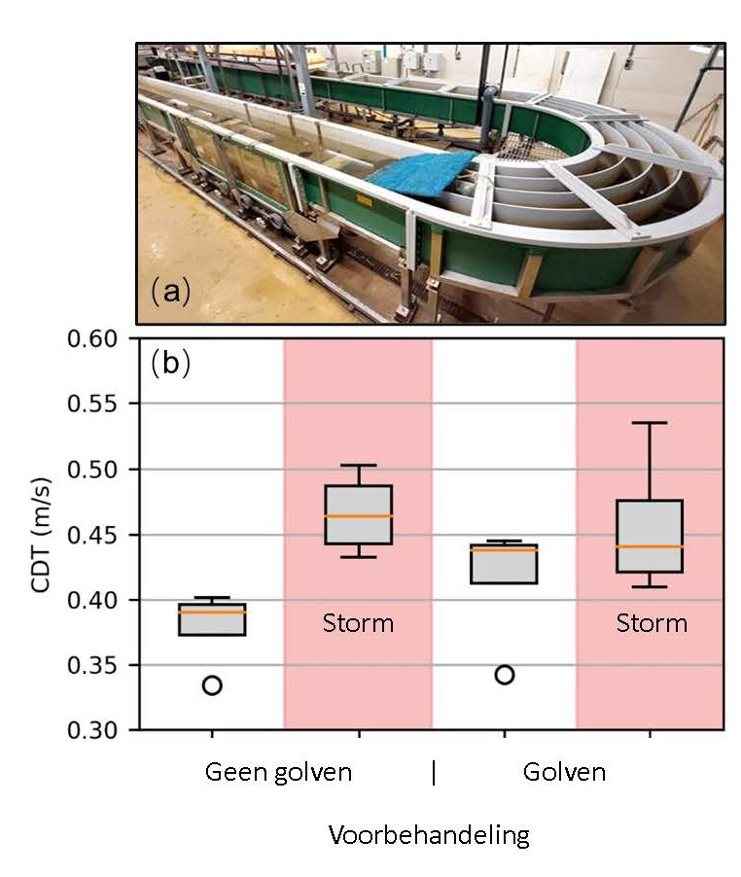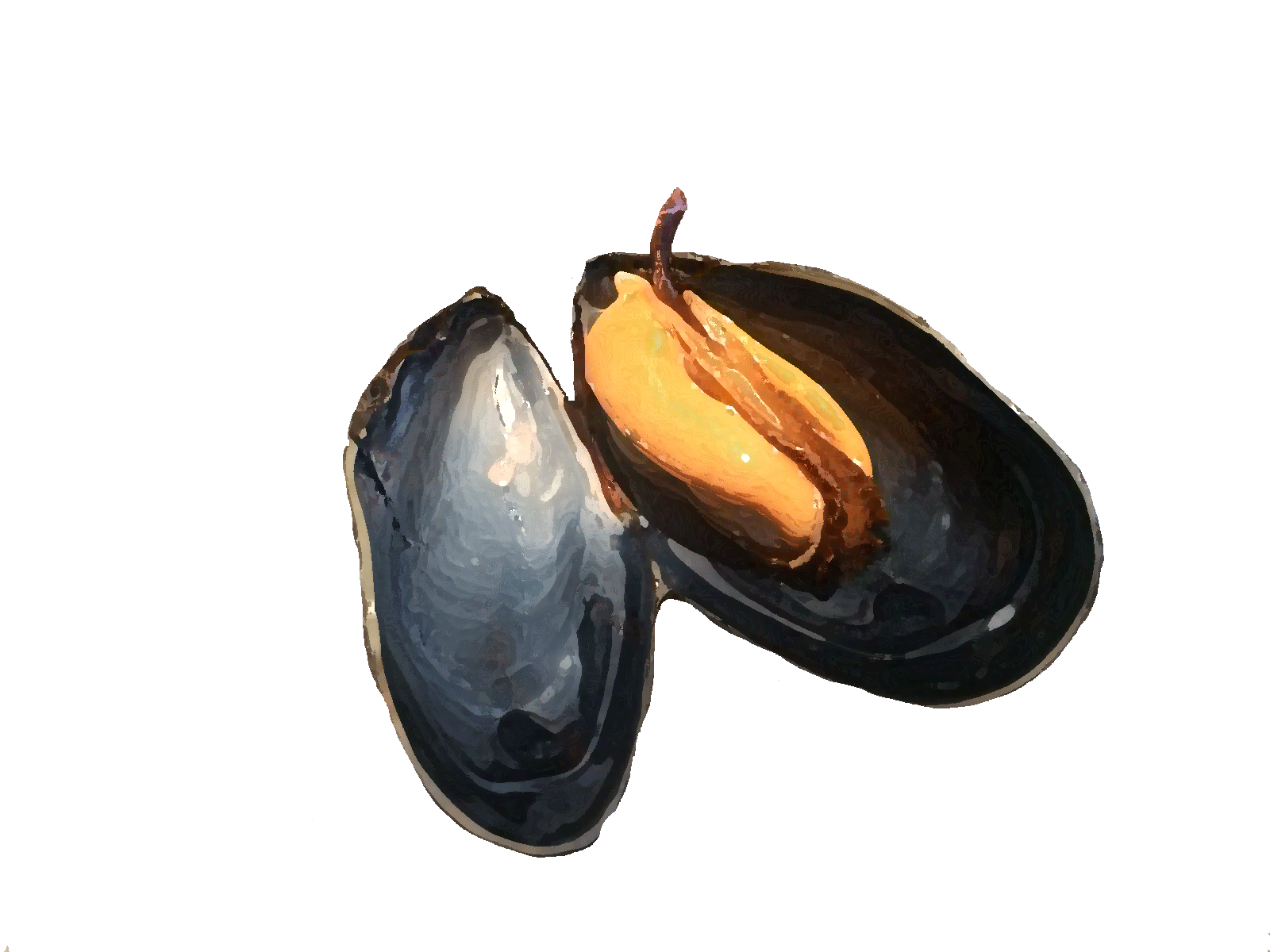Mussels that clump together in groups are initially well protected from being washed away by currents caused by waves. However, when they are washed away, it happens in those groups, which can lead to significant loss of mussel beds or breeding plots. The release of mussels from the bottom by runoff is determined by a threshold value. When this threshold is exceeded, many mussels may be released at the same time. The occurrence of mussel beds in the Dutch Wadden Sea shows a strong correlation with wave intensity. This suggests that washout of mussels during storms may be an important factor in the survival of mussel beds located at the ebb and flood interface. In mussel farming plots, the impact of storms on mussel washout can be even more significant. This is because the greater water depth generally leads to more vigorous movement of water close to the bottom due to storms. Understanding the thresholds and dynamics of mussel runoff risk is critical to understanding and potentially predicting mussel loss.
In this study, we conducted runoff experiments on constructed mussel beds in a stream channel in which waves can also be generated (Figure 5a). We wanted to investigate how the risk of washout of mussels depends on their recent history and duration of exposure to storm conditions. Prior to the measurements, we constructed 16 evenly spaced mussel beds (1.6 × 0.6 m) at a density of 10 kg/m² on substrate consisting of a mixture of sand and clamshells. These mussel beds were then subjected to different acclimation scenarios:
– Mussels were acclimated in stagnant water throughout.
– Mussels were acclimated in still water and then exposed to powerful waves (storm) for 3 days.
– Mussels were acclimated under gentle waves throughout.
– Mussels were acclimated under gentle waves and then exposed to powerful waves (storm) for 3 days.
The additional exposure to powerful waves simulated the effects of a prolonged storm. We were particularly interested in its influence on the critical threshold for runoff (CDT). During the tests, the waves were gradually increased by steps of about 0.05 m/s of bottom shear stress. Runoff was observed when the soil shear stress exceeded a certain threshold value. The CDT was calculated as the average of all peaks in soil shear stress during a 60-second period in which runoff occurred.
The results showed that storm duration has no significant influence on the critical threshold for detachment (CDT) (see the difference between waves and waves + storm exposure in Figure 1b), unless the mussels had never been exposed to waves before (see the difference between still and still + storm exposure in Figure 1b). This suggests that the mussels’ recent history determines how likely they are to become dislodged. Exposure to powerful waves did not affect CDT when mussels were acclimated under gentle waves, and CDT after exposure to waves was not affected by acclimation conditions (Figure 1b). This suggests that mussel release depends on the peak force of a storm rather than its duration.

Fig 1 (a) The flow channel for the runaway experiment. (b) Critical release threshold (CDT) of mussels under different treatments.In addition, we measured the movement of mussels on e
In addition to measuring in the stream channel, we also measured the movement of mussels on a mussel plot in the Wadden Sea that was exposed to waves. These measurements were made during the 2021-2022 storm season. We did this to measure the critical threshold for dislodging mussel beds on site. For this, we used small accelerometers (MSR 145B4) to record the movement of the mussels. These accelerometers have similar dimensions (62 x 20 x 14 mm) and weight (18 g) as young mussels, making them a good fit in a mussel cluster. About 10 live young mussels were attached to each accelerometer, creating small groups of mussels, each coupled to an accelerometer (referred to as Mussel Group Accelerometer, MCA; see Figure 2a). Simultaneously, we also measured wave motion using wave loggers. In total, we placed 30 MCAs and 6 wave loggers at different depths ranging from -4 to -2 m NAP for about 3 months (see Figure 2b).

Fig. 2(a) Photograph of the Mussel Group Accelerometer (MCA), which was used to measure the movement of mussels. (b) Location of the plot in the southwestern part of the Wadden Sea, where the wave loggers and MCAs were placed along a depth transect during the 2021-2022 field survey (wind vanes = wind measurements KNMI, Tide gauges = tide measurements RWS, Wave Buoys = wave gauges from RWS, Sensors = acceleration sensors + wave loggers, Commercial plots = mussel cultivation plots, Water depth = water depth relative to NAP)
Of the 30 MCAs placed, 12 were recovered. Of these 12, 9 had nested among the existing clams on the plot, while 3 were present as loose clumps. During the measurement period, conditions ranged from calm to stormy, resulting in multiple cycles of detachment and recovery (see Figure 7, upper section). During this measurement period, four significant storms occurred, three of which occurred within a 6-day period, leading to repeated moments of runoff (see Figure 7, bottom panel).

Fig 3. Top panel: Wave height and mean movement of mussels at one of the measurement locations where mussels nested in the mussels on the plot. Lower panel: conditions during the three storms in February 2022.
To determine the critical washout threshold (CDT) at the time when mussels were washed away, we calculated the bottom shear stress (referred to as “u”) based on wave heights according to linear wave theory. At low shear stress, loose MCAs, which are actually mussels that had become permanently detached, showed a higher degree of movement compared to MCAs that had attached to the mussels in the plot (see Figure 4). The motion began as early as u = 0.05 m/s and increased exponentially to its highest point at u = 0.3 m/s. MCAs attached to mussels remained stable at u < 0.1 m/s. Similar to loose MCAs, the intensity of motion of merged MCAs increased exponentially between u = 0.1 m/s and u = 0.3 m/s, but at a lower level. This indicates that mussels experience movement by waves, but are not torn apart. The difference between loose and plot-integrated MCAs decreased between u = 0.45 and u = 0.50 m/s, where a sudden increase in motion intensity occurred in plot-integrated MCAs. This marks the CDT. It also shows that washout is a sudden process affecting all mussels in the plot, as all MCAs distributed over a distance of 1 km showed the same sudden increase in movement intensity at the same soil shear stress.

Fig 4. Field measurements of the intensity of movement of loose and plot-integrated mussels as a function of soil shear stress.
Briefly, this study shows that the underwater dislodging of mussels is caused by a distinct threshold. This threshold is mainly determined by the history of the mussels and the intensity of the peak of the storm, rather than by the duration of the storm. Using an innovative approach, we measured for the first time the critical threshold for submerged mussel release in situ. Nevertheless, it is very important to measure this threshold under different flow conditions for a thorough risk assessment (link to: Stability of mussel beds under hydrodynamic stress). In addition, field research indicates that mussel dislodging is fairly frequent and that mussels recover thereafter, highlighting the importance of understanding the process of disturbance and recovery (link to Impact of successive storm events on mussel recoverability in plots).
de Smit, JC, Zhao, Z., Capelle, JJ, Gerkema, T, van de Koppel, J, Bouma, TJ, Uncovering hydrodynamic-driven dislodgement mechanisms in subtidal (commercial) mussel beds (in preparation for publication).

